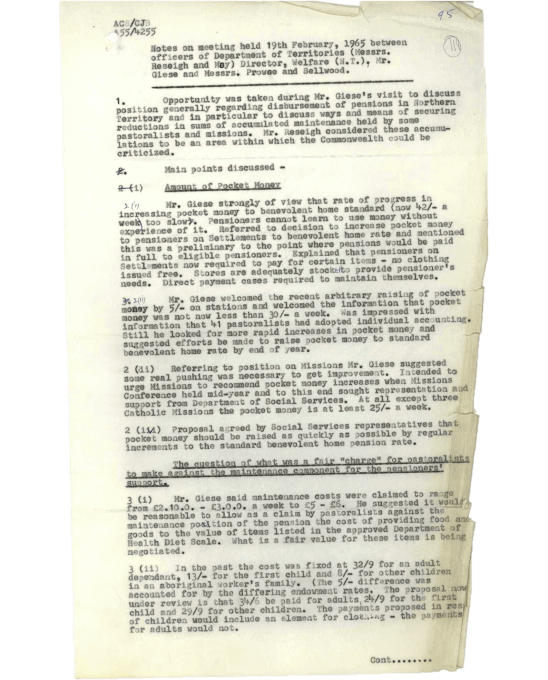
Officials discuss increasing ‘pocket money’ for people living on missions and stations
Aboriginal people living on stations and missions only received part of their government payment to manage themselves. In 1965, officials met to discuss how much this should be and how to standardise the amount people got.
Proposal [was] agreed by Social Services representatives that pocket money should be raised as quickly as possible by regular increments ...
| Attachment | Size |
|---|---|
| interdepartmental-meeting-excerpts.pdf | 1.29 MB |
| Attachment | Size |
|---|---|
| interdepartmental-meeting-plaintext.docx | 51.25 KB |
For many years, Aboriginal people living on missions and stations didn’t get their government payments directly. Instead, the government would pay the people who ran the missions and stations. Stations and missions could use most of the payment to cover ‘maintenance’ costs, such as for food and shelter. They were then meant to pay an amount of ‘pocket money’ to the Aboriginal residents. However, there wasn’t a set rate for how much missions and stations used and how much they had to give residents.
These notes from a meeting in Canberra on 19 February 1965 show discussions between government officials about this issue. Officials from the departments of Social Services and Territories, as well as the Northern Territory Director of Welfare, Harry Giese, attended.
The officials shared concerns about the different rates missions and stations were paying Aboriginal people, especially in the Northern Territory. While most stations paid 30 shillings a week, the maximum most missions paid was 25 shillings. Department of Social Services (DSS) officials agreed that the government should at least standardise the amount of pocket money Aboriginal people got.
Some officials also called for Aboriginal people to get more in pocket money. Giese in particular thought that Aboriginal people weren’t being paid enough. Some DSS officials agreed and said pocket money should be increased until all Aboriginal people got 2 pounds and 2 shillings weekly by January 1966.
Giese also raised concerns about how missions pooled money rather than keeping individual payments for individual people. This led to payments accumulating as missions and stations kept leftover maintenance money when people moved away or died. DSS officials said they would ‘keep pressing’ for payments to be used for individuals.
These extracts show how complex it was to monitor government payments for Aboriginal people on missions and stations. They also show the slow move throughout the 1960s to the government paying more Aboriginal people their full payments directly.
On the same date, the Department of Health and the Treasury met to discuss how Aboriginal people in institutions were paid. Institutions, such as hospitals, used payments in a similar way to missions and stations, with only part going to people directly.
These minutes and associated correspondence were kept in a file by the Department of the Interior. The file was later transferred to the National Archives of Australia, which holds it as part of the national archival collection.
You can access the file through RecordSearch. Go to pages 95–101.
Citation
National Archives of Australia: Department of the Interior; A1734, Correspondence files, 1933–1980; NT1969/960, Social Service Benefits for Aborigines – Northern Territory, 1964–1966.
